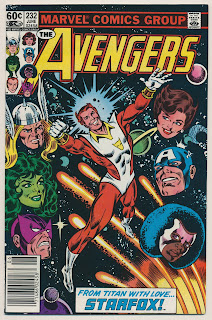by RM Rhodes
I was recently re-reading issues of Roger Stern’s run on The Avengers circa 1983 because I
remember reading those as a kid and I always got the impression that I didn’t
get the whole story. (As it turns out, I was right.) In some ways, this was the
flagship title of Marvel comics and represented a public face for what Marvel
comics felt their product should look like.
In that same year, 1983, in Brussels, these two gentlemen –
artist François Schuiten and his friend, writer Benoît Peeters – were well into
the establishment of a comic book universe of their own.
The difference between English language comics and French
language bandes dessinées (commonly shortened to BD) has been distinct for some
time. Where the American industrial comic product is typically a floppy
twenty-two (or so) page booklet every month (or so), the French industrial comic
product is weekly or monthly anthology magazines that provide episodes of an
ongoing story in anywhere from half- page (weekly) to multi-page (monthly)
increments. If the feature was considered popular enough, it would be collected
in a reprint edition. This makes for a complicated publishing history.
Les murailles de
Samaris, the first story in what would eventually be known as
Les Cites Obscures, was originally serialized in French in Casterman’s monthly anthology,
A Suivre (English translation: To Be
Continued), in 1982. Casterman released a collected edition in 1983 that is
still in print. The story first appeared in English, in the
Heavy Metal November 1984 to March 1985
issues under the name
The Great Walls of
Samaris, although the ending was badly mutilated and the translation is
generally considered to be sub-par. NBM published a collected edition in 1987
and called the series the Stories of the Fantastic. They kept the
Heavy Metal translation but fixed the
ending. Copies of the NBM printing can cost $45 or more, but thankfully IDW
released a new version with a better translation in 2017. This version comes with
a translation of four episodes of an unfinished story that appeared in various
issues of
A Suivre and other
publications.

Many of the older stories in the series were also serialized
in A Suivre prior to collection,
including La fièvre d'Urbicande
(original 1983, Casterman collection in 1985, NBM collection in 1990); La Tour (original 1985, Casterman in
1987, NBM in 1993); and Brusel
(original 1990, Casterman 1992, NBM 2001). By the time Brusel came out in English, the translation of the series name had been changed to Cities of the Fantastic.
There are still several stories in the series that have
never been translated into English, including L'archiviste, L'Écho des
cites, Le Guide des cites and L'ombre d'un homme. This latest round of
translations from IDW are a result of Stephen Smith’s decision to translate and
publish the entire run through his Alaxis Press, under the more accurately
translated series name The Obscure Cities. The first book was The Leaning Girl in 2014 and IDW
partnered with Alaxis Press for The
Theory of a Grain of Sand in 2016. Samaris
is the third edition in this collaboration.

It was smart of Smith (and IDW) to start with the
untranslated books first and work back to earlier translations. The original
NBM books were thin and printed on cheaper paper and tried to match the format
of Asterix collections. The newer printings in French are lush, with a better
paper quality, better coloring, and better overall production values. In fact, the newer editions
produced by IDW are more-or-less indistinguishable from their European versions
except for the language they are printed in.

As a consistent creative team, Schuiten and Peeters have been
allowed to flesh out their universe at their own speed. Because of the way that
French-language comics are serialized, there was no concern about having to
maintain a consistent commercial presence in A Suivre. They just showed up when they needed a place to serialize
their latest work and Casterman kept the collections in print. There has been
no change in artistic teams, and it would be very odd to think of anyone but
Schuiten and Peeters producing something in the series – although they have had
artistic collaborators (eg the photographed sections of The Leaning Girl.)

As the title implies, these art nouveau-inspired pre-steampunk science fantasy stories
are all about various cities on a massive continent on an alien world that is
not ours (although there is a suggestion that it’s a planet on the other side of the sun from Earth). The
mysteries of these cities add to the appeal of the series, as oblique
references to one story often show up in another. Research and/or investigation
is a consistent theme throughout and there is an entire book – L’archiviste – that is centered around
research into artifacts from these cities and, as a result, contains a healthy
heaping of references to other stories, including some that had not been made
when L’archiviste was originally
printed. You know, the sort of thing that makes people build websites to
explain the whole thing. More than anything else, this shared universe
presentation makes the comparison to The Avengers feel very apt.

Schuiten’s illustrative art style, however, is significantly
different than most English-language commercial comic work and it has gotten
better over time. He was trained as an
architect (his brother and father are practicing architects as well) and it
shows in his work. Indeed, Schuiten’s illustrative art style is so detailed and
distinctive that it sets the entire series apart from the pack. The reader is immediately
drawn to the art and is pleasantly surprised that the stories are good.

This is almost a textbook example of how a specific art
style meshes with a hyper-realistic kind of worldbuilding – and
Benoit Peetershas actually produced a definitive piece about page layout. There is a lot of
material that has not yet been translated and one can only hope that sales have
been good enough to encourage IDW to finish the task. Between this and the
Corto Maltese reprints (also published by Casterman in Europe), IDW deserves much more
recognition. And now that I’ve got their attention, can I request a translation
of the other stories by
Pellejero and Zentner? That would be great.
__________________________________________________________
Why is this here? It's a long story. Mike Rhode first introduced himself to me when I first started vending at SPX. Over the years, we've talk to each other at Comic conventions around the DC area and never quite get around to sitting down for lunch.
When I moved to Arlington two years ago, I didn't realize that Mike lived within a mile of my building. Nor did I realize that he lived next door to my girlfriend's friend from college. We also discovered, by accident that we work two buildings away from each other, because we work in adjacent organizations. The world is a very small place, sometimes.
It really feels that way when I run into Mike at the local farmer's market. Naturally, that's when I pitch him article ideas. I'm reading the entire run of Heavy Metal in public (in blog format) because I happen to own the entire run of Heavy Metal. This means that I'm engaged in an ongoing study of the magazine. In addition, I have a diverse and idiosyncratic reading list that tends towards the weird corners of comics history. Sometimes one circumstance or another results in long articles that I don't really have anyplace to put. Mike has been gracious enough to let me publish them here.
In summary: this is an article about comics from someone in the DC area.
































 Molly Crabapple is an artist and writer in New York. Her memoir,
Molly Crabapple is an artist and writer in New York. Her memoir,  Latoya Peterson is deputy editor of digital innovation for ESPN's The Undefeated, where she works across editorial, product and data teams to help implement trailblazing new forms of storytelling. Peterson is editor/owner of the award-winning blog, Racialicious, covering the intersection of race and pop culture. Forbes magazine named her one of its 30 Under 30 rising stars in media for 2013. Her work has been published in ESPN Magazine, The New York Times, The Washington Post, Essence, Spin, Vibe, Marie Claire, The American Prospect, the Guardian and others. Her honors and fellowships include being a John S. Knight Journalism Fellow at Stanford University, focusing on mobile technology and digital access; a Harvard Berkman Center Affiliate, a Poynter Institute Sensemaking Fellow, and one of the inaugural Public Media Corps Fellows.
Latoya Peterson is deputy editor of digital innovation for ESPN's The Undefeated, where she works across editorial, product and data teams to help implement trailblazing new forms of storytelling. Peterson is editor/owner of the award-winning blog, Racialicious, covering the intersection of race and pop culture. Forbes magazine named her one of its 30 Under 30 rising stars in media for 2013. Her work has been published in ESPN Magazine, The New York Times, The Washington Post, Essence, Spin, Vibe, Marie Claire, The American Prospect, the Guardian and others. Her honors and fellowships include being a John S. Knight Journalism Fellow at Stanford University, focusing on mobile technology and digital access; a Harvard Berkman Center Affiliate, a Poynter Institute Sensemaking Fellow, and one of the inaugural Public Media Corps Fellows. 






